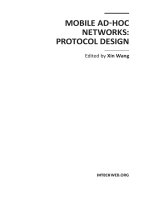Mobile Ad Hoc Networks Protocol Design Part 1 pptx
Bạn đang xem bản rút gọn của tài liệu. Xem và tải ngay bản đầy đủ của tài liệu tại đây (2.72 MB, 40 trang )
MOBILE ADͳHOC
NETWORKS:
PROTOCOL DESIGN
Edited by Xin Wang
Mobile Ad-Hoc Networks: Protocol Design
Edited by Xin Wang
Published by InTech
Janeza Trdine 9, 51000 Rijeka, Croatia
Copyright © 2011 InTech
All chapters are Open Access articles distributed under the Creative Commons
Non Commercial Share Alike Attribution 3.0 license, which permits to copy,
distribute, transmit, and adapt the work in any medium, so long as the original
work is properly cited. After this work has been published by InTech, authors
have the right to republish it, in whole or part, in any publication of which they
are the author, and to make other personal use of the work. Any republication,
referencing or personal use of the work must explicitly identify the original source.
Statements and opinions expressed in the chapters are these of the individual contributors
and not necessarily those of the editors or publisher. No responsibility is accepted
for the accuracy of information contained in the published articles. The publisher
assumes no responsibility for any damage or injury to persons or property arising out
of the use of any materials, instructions, methods or ideas contained in the book.
Publishing Process Manager Iva Lipovic
Technical Editor Teodora Smiljanic
Cover Designer Martina Sirotic
Image Copyright Andreas Guskos, 2010. Used under license from Shutterstock.com
First published January, 2011
Printed in India
A free online edition of this book is available at www.intechopen.com
Additional hard copies can be obtained from
Mobile Ad-Hoc Networks: Protocol Design, Edited by Xin Wang
p. cm.
ISBN 978-953-307-402-3
free online editions of InTech
Books and Journals can be found at
www.intechopen.com
Chapter 1
Chapter 2
Chapter 3
Chapter 4
Chapter 5
Chapter 6
Chapter 7
Part 2
Chapter 8
Preface IX
Quality of Service and Video Commucation
in Ad Hoc Networks 1
QoE Enhancement of Audio-Video IP Transmission
in Cross-Layer Designed Ad Hoc Networks 3
Toshiro Nunome and Shuji Tasaka
Quality of Service (QoS) Provisioning
in Mobile Ad-Hoc Networks (MANETs) 23
Masoumeh Karimi
Video Communications Over Wireless Ad-Hoc Networks
Using Source Coding Diversity and Multiple Paths 39
Yiting Liao and Jerry D. Gibson
Available Bandwidth Estimation
and Prediction in Ad hoc Networks 61
Haitao Zhao, Jibo Wei, Shan Wang and Yong Xi
Mathematic Models for Quality
of Service Purposes in Ad Hoc Networks 85
Khalil Amine
Towards Reliable Mobile Ad Hoc Networks 99
Ricardo Lent and Javier Barria
ADHOCTCP: Improving TCP
Performance in Ad Hoc Networks 121
Seyed Mohsen Mirhosseini and Fatemeh Torgheh
Cross Layer Design in Ad Hoc Networks 139
Cross–Layer Design in Wireless Ad Hoc
Networks with Multiple Antennas 141
Ehsan Soleimani-Nasab, Mehrdad Ardebilipour and Mahdi Kashiha
Contents
Contents
VI
Performance Modeling of MAC
and Multipath Routing Interactions
in Multi-hop Wireless Networks 167
Xin Wang, J.J. Garcia-Luna-Aceves, Hamid R. Sadjadpour
A Bandwidth Reservation QoS Routing
Protocol for Mobile Ad Hoc Networks 185
Wen-Hwa Liao
Link Quality Aware Robust Routing
for Mobile Multihop Ad Hoc Networks 201
Sangman Moh, Moonsoo Kang, and Ilyong Chung
A Location Prediction Based Routing Protocol
and its Extensions for Multicast and Multi-path
Routing in Mobile Ad hoc Networks 217
Natarajan Meghanathan
An Adaptive Broadcasting Scheme
in Mobile Ad Hoc Networks 243
Dimitrios Liarokapis and Ali Shahrabi
Predictive RSS with Fuzzy Logic
based Vertical Handoff Decision Scheme
for Seamless Ubiquitous Access 261
Sunisa Kunarak and Raungrong Suleesathira
Energy Issues and Energy aware Routing
in Wireless Ad-hoc Networks 281
Marco Fotino and Floriano De Rango
Routing in Ad Hoc Networks 297
Routing in Mobile Ad Hoc Networks 299
Fenglien Lee
Fault-Tolerant Routing
in Mobile Ad Hoc Networks 323
B. John Oommen and Luis Rueda
LLD: Loop-free Link Metrics
for Proactive Link-State Routing
in Wireless Ad Hoc Networks 345
Takuya Yoshihiro
Stability Oriented Routing in Mobile Ad-Hoc
Networks Based on Simple Automatons 363
Miklós Molnár and Raymond Marie
Chapter 9
Chapter 10
Chapter 11
Chapter 12
Chapter 13
Chapter 14
Chapter 15
Part 3
Chapter 16
Chapter 17
Chapter 18
Chapter 19
Contents
VII
Capacity, Bandwidth, and Available Bandwidth in
Wireless Ad Hoc Networks: Definitions and Estimations 391
Marco A. Alzate, Néstor M. Peña and Miguel A. Labrador
QoS Routing Solutions
for Mobile Ad Hoc Network 417
Jiwa Abdullah
A Novel Secure Routing Protocol for MANETs 455
Zhongwei Zhang
Other Topics 467
Security and Dynamic Encryption System
in Mobile Ad-Hoc Network 469
Peter H. Yu and Udo W. Pooch
Security of Access in Hostile Environments
Based on the History of Nodes in Ad Hoc Networks 491
Saud Rugeish Alotaibi
Trust Establishment in Mobile Ad Hoc Networks:
Direct Trust Distribution-Performance and Simulation 513
Dawoud D.S., Richard L. Gordon,
Ashraph Suliman and Kasmir Raja S.V.
Data Delivery in Delay Tolerant Networks:
A Survey 565
Shyam Kapadia, Bhaskar Krishnamachari and Lin Zhang
Broadcasting in Moblie Ad Hoc Networks 579
Sangwoo Lee and Chaewoo Lee
Energy Efficient Resource Allocation
in Cognitive Radio Wireless Ad Hoc Networks 595
Song Gao, Lijun Qian, and D.R. Vaman
Theory and Applications of Ad Hoc Networks 615
Takuo Nakashima
The Dimensioning of Non-Token-Bucket Parameters
for Efficient and Reliable QoS Routing Decisions
in Bluetooth Ad Hoc Network 639
Halabi Hasbullah and Mahamod Ismail
Chapter 20
Chapter 21
Chapter 22
Part 4
Chapter 23
Chapter 24
Chapter 25
Chapter 26
Chapter 27
Chapter 28
Chapter 29
Chapter 30
Pref ac e
Mobile Ad hoc Networks (MANETs) are a fundamental element of pervasive networks,
where user can communicate anywhere, any time and on-the-fl y. MANETs int roduce
a new communication paradigm, which does not require a fi xed infrastructure - they
rely on wireless terminals for routing and transport services. This edited volume
covers the most advanced research and development in MANET. It seeks to provide an
opportunity for readers to explore the emerging fi elds about MANET.
It includes four parts in total. Part 1 discusses the quality of service and video
communication in MANET. Part 2 introduces some novel approaches in cross-layer
protocol design. Part 3 focuses on the routing protocols. Some interesting topics about
security, power consumption, capacity, etc. are discussed in Part 4.
Acknowledgements
The editors are particularly grateful to the authors who present their work in this book.
They would also like to express their sincere thanks to all the reviewers, who helped
to maintain the high quality of this book. We hope that the readers will share our
excitement to present this volume on ad-hoc networks and will fi nd it useful.
Prof. Xin Wang
University of California, Santa Cruz,
USA
Part 1
Quality of Service and Video Commucation
in Ad Hoc Networks
1
QoE Enhancement of Audio-Video
IP Transmission in Cross-Layer
Designed Ad Hoc Networks
Toshiro Nunome and Shuji Tasaka
Nagoya Institute of Technology
Japan
1. Introduction
The QoE (Quality of Experience), which is perceptual quality for the users, is the most
important QoS (Quality of Service) among those at all levels since the users are the ultimate
recipients of the services. Even in mobile ad hoc networks (MANET), provision of high QoE is
one of the most important issues.
Some applications of ad hoc networks require the ability to support real-time multimedia
streaming such as live audio and video over the networks. Therefore, the realization of this
type of service with high quality is highly demanded; nevertheless, it is very difficult to
achieve high quality in ad hoc networks.
The cross-layer design architecture (Srivastava & Motani, 2005) is expected as an approach
to high quality communication in ad hoc networks. The architecture exploits interaction
among more than two layers. Although the layered architecture in IP-based networks has
some advantages such as reduction of network design complexity, it is not well suited to
wireless networks. This is because the nature of the wireless medium makes it difficult to
decouple the layers.
There are many studies on the cross-layer design architecture for multimedia streaming. The
number of hops maintained by the routing protocol is used for selecting the video coding
rate to the network capacity (Gharavi & Ban, 2004), (Zhao et al., 2006). If there are many
hops from the sender to the receiver, the approach reduces the coding rate at the sender. It is
a cross-layer design between the network and application layers. Abd El Al et al. (2006) have
proposed an error recovery mechanism for real-time video streaming that combines FEC
and multipath retransmission. This scheme determines strength of the error correction code
and a quantization parameter for video encoding according to the number of hops. Frias et
al. (2005) exploit the multipath routing protocol for scheduling prioritized video streams
and best effort traffic. They schedule the traffic on the basis of the number of multiple
routes. Nunome & Tasaka (2005) have proposed the MultiPath streaming scheme with Media
Synchronization control (MPMS). It treats audio and video as two separate transport streams
and sends the two streams to different routes if multipath routes are available. Furthermore,
in order to remedy the temporal structure of the media streams disturbed by the multipath
transmission, media synchronization control is employed; it is application-level QoS control.
Mobile Ad-Hoc Networks: Protocol Design
4
While the above approaches refer to cross-layering between the network and application
layers, Setton et al. (2005) have explored a new framework for cross-layer design that
incorporates adaptation across all layers of the protocol stack: application, transport
protocols, resource allocation, and link layer techniques. It should be noted that all of the
previous studies mentioned above do not evaluate the QoE of transmitted multimedia
streams. Furthermore, these studies except for (Nunome & Tasaka, 2005) consider video
only and do not assess its temporal quality.
The routing protocol is an essential component in ad hoc networks. The link quality-based
routing is one of the most promising approaches to establishment of routes with high quality
and high throughput. It has been studied as QoS routing (Zhang & Mouftah, 2005) and
multirate aware routing (Lin et al., 2003), (Seok et al., 2003). It can avoid using links with low
data rates by taking account of link quality such as signal strength and link utilization level
for route selection; this implies a cross-layer design among the network and lower layers.
The aim of this chapter is to achieve high QoE of audio and video streams transmitted over
ad hoc networks. The cross-layer design with media synchronization control and the link
quality-based routing can be one of the most effective solutions for this purpose.
In this chapter, we assess application-level QoS and QoE of audio-video streaming with
media synchronization control and link quality-based routing protocols in a wireless ad hoc
network. We adopt three link quality-based routing protocols: OLSR-SS (Signal Strength)
(Itaya et al., 2005), AODV-SS (Budke et al., 2006), and LQHR (Link Quality-Based Hybrid
Routing) (Nakaoka et al., 2006). OLSR-SS is a modified version of OLSR (Clausen & Jacquet,
2003), which is a proactive routing protocol. AODV-SS is a reactive protocol based on
AODV (Perkins et al., 2003). LQHR is a hybrid protocol, which is a combination of proactive
and reactive routing protocols. We clarify advantages and disadvantages of the three types
in audio-video streaming with media synchronization control.
The quality of the audio-video stream can fluctuate largely in ad hoc networks, and then it is
difficult to assess the QoE. That is, the assessment method is one of the important research
issues. We employ a continuous time assessment method of QoE in audio-video
transmission proposed in (Ito et al., 2005); it utilizes the method of successive categories (Tasaka
& Ito, 2003), which is a psychometric method, continuously in time.
The rest of this chapter is organized as follows. Section 2 explains link quality-based routing
protocols for ad hoc networks. We introduce the continuous time assessment method of
QoE in Section 3. Section 4 illustrates a methodology for the QoS/QoE assessment,
including the network configuration, simulation method, QoS parameters, and QoE
assessment method. The QoS assessment results are presented and discussed in Section 5.
Section 6 discusses the result of QoE assessment.
2. Link quality-based routing
A variety of studies on link quality-based routing protocols have been reported. As in
traditional hop-based routing protocols, they can be classified into three categories:
proactive, reactive, and hybrid. We then give an overview of the three types of protocols.
2.1 Proactive routing protocol
The proactive routing protocol periodically exchanges the routing information between
nodes. The protocol performs well for fixed or low mobility networks.
QoE Enhancement of Audio-Video IP Transmission in Cross-Layer Designed Ad Hoc Networks
5
Itaya et al. (2005) have proposed two techniques of multi-rate aware routing for improving
the stability of communication. The first technique is employment of a threshold for signal
strength (SS) of received routing packets. It is used to avoid routing packets via unreliable
neighbors with poor radio links. The second technique is synchronous update (SU) of routing
tables. It is used to avoid loops due to mismatch in timing of route updates. The techniques
can be implemented as modifications to conventional routing protocols. They have
implemented these techniques into OLSR. Although the first technique can be applied to
reactive routing protocols, they have implemented nothing in (Itaya et al., 2005).
As the proactive routing protocol for the comparison in this chapter, we employ the scheme
proposed in (Itaya et al., 2005) with a little modification. The threshold for signal strength is
kept constant for simplicity; in this chapter, we denote the threshold by T
h
. Furthermore, we
assume that the time synchronization among the nodes is performed completely, because
the simulation environment can get the global time synchronization automatically. We refer
to the scheme as OLSR-SS, although it is called OLSR-SS-SU in (Itaya et al., 2005).
2.2 Reactive routing protocol
The reactive routing protocol discovers routing paths when the source wants to send data;
that is, it works on demand. It is appropriate for the use in highly mobile networks.
For example, Fan (2004) proposes high throughput reactive routing in multi-rate ad hoc
networks. He modifies the AODV protocol in order to select suitable links with high data
rates. In the scheme, the routing cost is calculated on the basis of MAC delay, which is equal
to total delay of RTS/CTS/DATA/ACK communication. However, the scheme needs the
information on the transmission speed of each link; that is, it is not a pure reactive scheme.
On the other hand, Budke et al. (2006) evaluate the QoS extensions for supporting real-time
multiplayer game applications in IEEE 802.11 mobile ad hoc networks. They select AODV
and add signal strength monitoring for Route Request (RREQ) packets. That is, the scheme
can be regarded as a reactive version of the scheme proposed in (Itaya et al., 2005); thus, we
refer to the scheme as AODV-SS.
In this chapter, as the reactive routing protocol for the comparison, we specify AODV-SS as
follows. When an intermediate node receives RREQ, it decides whether the packet should be
forwarded or not by received signal strength. If the received signal strength at the
intermediate node is lower than the threshold T
h
, which is the same as that in OLSR-SS, the
node drops the packet.
2.3 Hybrid routing protocol
The hybrid routing protocol is a combination of proactive and reactive routing protocols.
Nakaoka et al. (2006) propose LQHR. In LQHR, each node maintains routing information
produced by an existing proactive routing protocol and measures link quality between the
neighboring nodes. When a source node makes a communication request which needs high
quality links, it selects a route to the destination node by referring to the link quality on an
on-demand basis.
LQHR takes account of link quality representing both reliability and the link utilization level
of each node. We revise the LQHR algorithm in order to overcome difficulties related to
networks with many route selections.
LQHR consists of two modules:
Mobile Ad-Hoc Networks: Protocol Design
6
• Quality Measurement (QM) Module
The QM module produces and maintains routing information by means of a proactive
routing protocol; for example, OLSR is employed in (Nakaoka et al., 2006). It also
periodically measures the link quality between adjacent nodes. The link quality is
represented as a vector whose components are some quality parameters.
• Route Selection (RS) Module
The RS module selects a route to the destination node by referring to the link quality,
which is measured by the QM module, on an on-demand basis when a communication
request is made at a node.
1
5
Source Destination
2
3
4
Last-hop
node
Possible next-hop nodes
for source
Next-hop node
selected by proactive routing
Fig. 1. Example of route discovery in LQHR.
On having a communication request, the source node sends a Route Quality Request (RQReq)
message to each of the possible next-hop nodes. The possible next-hop node is a candidate of
the next-hop node on the route to the destination. For example, in Fig. 1, we assume that
node 1 is the source node and that node 5 is the destination node. Then, nodes 2 and 3 are
the possible next-hop nodes for node 1.
The nodes receiving the RQReq message refer to the destination address and then forward it
to each of their own possible next-hop nodes. The RQReq message is forwarded up to last-
hop nodes. The last-hop node means the single-hop neighbor node to the destination. In Fig.
1, node 4 is the last-hop node to node 5.
Once the RQReq message reaches the last-hop node, it forwards back a Route Quality
Response (RQRsp) message, via the series of the possible next-hop nodes the RQReq message
has gone through, finally to the source node; thus a route from the source to the destination
is selected. The RQRsp messages are chosen and discarded on the way to the source node on
the basis of the link quality of each forwarding node.
In this chapter, we impose two restrictions on the algorithm of LQHR in order to overcome
problems related to networks with many route candidates; many RQReq and RQRsp packets
are generated, and then the effectiveness of the route discovery mechanism may degrade. One
restriction is for the possible next-hop nodes, and the other is for the last-hop nodes.
At first, the revised algorithm restricts the possible next-hop nodes. The original LQHR
algorithm sends RQReq packets to all the possible next-hop nodes. However, if there are
many possible next-hop nodes, this is not a good strategy because the node will generate
many RQReq packets, which cause congestion. Thus, the revised algorithm sends RQReq
packets to only r
1
nodes which has higher link quality than other nodes. In this chapter, we
set the value of r
1
to 5.
In addition, we also employ the following condition for the possible next-hop nodes. When
link quality between two nodes is very high at each node, the two nodes may be
QoE Enhancement of Audio-Video IP Transmission in Cross-Layer Designed Ad Hoc Networks
7
geometrically close to each other. If the routing algorithm selects such links, the route will
have a large number of hops. Thus, a node does not send RQReq packets to a possible next-
hop node in which the link between the two nodes is one of the best r
2
links. In this chapter,
we set the value of r
2
to 3.
Next, the revised algorithm also restricts the last-hop nodes. In some topology, there are a
large number of last-hop nodes. However, it may not be true that all the candidates of last-
hop nodes have good quality links to the destination node. Thus, as the last-hop node, the
algorithm permits only nodes with the link to the destination whose quality is larger than
the threshold T
h
.
3. Continuous time assessment of QoE
In this chapter, we employ the method of continuous time QoE assessment in (Ito et al.,
2005). This section describes the method, which utilizes the method of successive categories
continuously in time.
3.1 Method of successive categories
For a start, we introduce four types of measurement scales. With the psychometric methods,
the human subjectivity can be represented by a measurement scale. We can define four
types of the measurement scales according to the mathematical operations that can be
performed legitimately on the numbers obtained by the measurement; from lower to higher
levels, we have nominal, ordinal, interval, and ratio scales (Guilford, 1954). Since almost all the
statistical procedures can be applied to the interval scale and the ratio scale, it is desirable to
represent the QoE by an interval scale or a ratio scale. With the psychometric methods used
in (Tasaka & Ito, 2003), we can represent QoE by an interval scale.
In the method of successive categories, a subjective score is measured by the rating scale
method (Guilford, 1954), in which subjects classify each stimulus into one of a certain number
of categories. Here, a stimulus means an object for evaluation, such as audio and video. Each
category has a predefined number. For example, “excellent” is assigned 5, “good” 4, “fair” 3,
“poor” 2, and “bad” 1. However, in the strict sense, we cannot use the assigned number for
assessing the QoE since the assigned number is an ordinal scale.
In order to obtain an interval scale as the QoE metric, we first measure the frequency of each
category with which the stimulus was placed in the category by the rating-scale method.
With the law of categorical judgment (Tasaka & Ito, 2003), we can translate the frequency
obtained by the rating-scale method into an interval scale. We can apply almost all the
operations to the scale.
3.2 The Law of Categorical Judgment
The law of categorical judgment makes the following assumptions. Let the number of the
categories be m +1. When stimulus j (j = 1, …,n) is presented to an assessor, a psychological
value designated by s
j
occurs on an interval scale in him/her. For the m + 1 categories, their
boundaries have values on the interval scale. We denote the upper boundary of category g (g
= 1, … ,m + 1) by c
g
and define c
0
−∞ and c
m+1
+∞. The assessor sorts n stimuli into the m
+ 1 categories (n > m + 1) by comparing s
j
with c
g
. If c
g−1
< s
j
≤ c
g
, then stimulus j is classified
into category g. The categories can be arranged in a rank order, in the sense that each
stimulus in category g is judged to have a psychological value which is “less than” the one
Mobile Ad-Hoc Networks: Protocol Design
8
for any stimulus in category g + 1. This statement holds for all values of g from 1 to m. The
variable c
g
is normally distributed with mean t
g
and standard deviation d
g
. Also, the variable
s
j
is normally distributed with mean R
j
and standard deviation σ
j
. Then, we can consider R
j
as an interval scale.
Since the law of categorical judgment is a suite of assumptions, we must test goodness of fit
between the obtained interval scale and the measurement result. Mosteller proposed a
method of testing the goodness of fit for a scale calculated with Thurstone’s law (Mosteller,
1951). The method can be applied to a scale obtained by the law of categorical judgment. In
this chapter, we use Mosteller’s method to test the goodness of fit.
3.3 Continuous time QoE assessment with the method of successive categories
We utilizes the method of successive categories continuously in time. The audio-video
stream for evaluation is partitioned into many fragments each with time length Δ. For
example, a stream with total length T is divided into T/Δ or T/(Δ + 1) fragments. We regard
each fragment as a stimulus and utilize the method of successive categories for all stimuli
(fragments). That is, assessors classify the current fragment into one of the categories every
Δ. Then, we apply the law of categorical judgment to the result for all fragments.
Since the assessor only has to judge which one of the categories is the most appropriate for
the stimulus every Δ, the method imposes little burden on the assessor. Moreover, by setting
the number of categories to 3 or 5, the assessors can continuously enter their judgment in an
input device by their fingers without directing their attention to the device. In addition to
this, by utilizing the law of categorical judgment, we can obtain values of QoE metric in the
form of the interval scale.
4. Methodology of QoS/QoE assessment
We assess the application-level QoS and the QoE of audio-video streaming in ad hoc
networks with the three schemes of link quality-based routing: LQHR, OLSR-SS, and
AODV-SS. For this purpose, we performed computer simulation with ns-2 (network simulator
version 2).
Video stream
MPEG1
Audio trace file
(MU size, interval)
Video trace file
(MU size, interval,
picture pattern)
ns-2
Audio time chart
(MU output time)
Video time chart
(MU output time)
Audio-video
player
User (assessor)
input output
convert
Application-level QoS
QoE
convert
input
input
auditory
visual
Fig. 2. Schematic diagram of QoS/QoE assessment.
Figure 2 shows the schematic diagram of the QoS/QoE assessment. We refer to the
transmission unit at the application-level as a Media Unit (MU); we define a video frame as a
video MU and a constant number of audio samples as an audio MU. From the practical
audio and video streams, we get traffic trace files for the simulation. The files include each
MU size and inter-MU time. In addition, the file for video also includes the picture type of
QoE Enhancement of Audio-Video IP Transmission in Cross-Layer Designed Ad Hoc Networks
9
each video MU. In the simulation, we take into consideration the capturing and encoding
delay time before the transmission procedure in order to emulate the audio-video streaming
inputted real-time. With the traffic trace files and a simulation scenario, ns-2 outputs time
charts in which the output timing of each MU is described. We can achieve application-level
QoS parameter values by the time charts. Furthermore, for the QoE assessment, the audio-
video player plays the practical audio-video stream with the output timing obtained from
the time charts.
4.1 Network configuration
In this chapter, we consider a simple mesh topology network to assess the characteristics of
the three schemes of link quality-based routing with media synchronization control in ad
hoc networks. The network consists of 24 nodes as shown in Fig. 3. Each node has an omni-
directional antenna. We employ the shadowing model (Rappaport, 1996) as the propagation
model in the simulation. In the model, received signal strength at the receiver is determined
by the following equation:
dB
00
dB
()
10 log
()
r
r
Pd
d
X
Pd d
β
⎡⎤ ⎛⎞
=− +
⎜⎟
⎢⎥
⎜⎟
⎣⎦ ⎝⎠
(1)
If P
r
(d) exceeds the threshold of received signal strength, the packet can be received. Here, β
means path loss exponent and is set to 2 in the simulation. d
0
is close-in distance and is set to
1.0. X
dB
shows a Gaussian random variable; the average and the standard deviation are set
to 0 and 4.0, respectively. These are default values in ns-2. The model does not consider
propagation errors or fading.
In the simulation, we assume seven patterns of the mesh topology by changing the distance
between two vertically or horizontally adjacent nodes; we refer to the distance as the inter-
node distance.
In mesh topology networks, there are many available routes; therefore, the networks are
suitable for the assessment of the behavior of routing schemes. However, it should be noted
that as a next step of this study, we need assessment in more practical topology networks
like those with many mobile nodes.
Fig. 3. Network configuration.
We formulate a detailed simulation model which is based on the distributed coordination
function (DCF) of the IEEE 802.11b. The transmission speed is automatically changed from 2
Mb/s to 11 Mb/s by means of the rate adaptation mechanism. In this chapter, we employ
Mobile Ad-Hoc Networks: Protocol Design
10
ARF (Automatic Rate Fallback) (Kamerman & Monteban, 1997). The transmission speed is
controlled for each link, and broadcast frames are transmitted at 2 Mb/s. The maximum
number of trials of frame retransmission is set to four. The RTS/CTS mechanism is not used
in the simulation, because it has been reported that the conventional RTS/CTS mechanism
does not work well in ad hoc networks (Xu et al., 2002), (Ray et al., 2003).
Because the received signal strength changes dynamically in the shadowing model, the
communication range of each node fluctuates in time and is determined by the transmission
speed. In the simulation, a node can receive a packet with probability 0.95 when the distance
between the node and the sender is 34.54 m at 11 Mb/s, 48.36 m at 5.5 Mb/s, and 62.17 m at
2 Mb/s. These values are calculated by the threshold program, which is included in ns-2.
4.2 Method of simulation
In Fig. 3, we assume MS (Media Source) as the audio and video sources. MS transmits the
media streams to MR (Media Receiver) with RTP/UDP. We use an audio stream of ITU-T
G.711 μ-law and an MPEG1 video stream, which have been prepared by encoding a part of
Japanese news program. Table 1 shows the specifications of the audio and video.
In the simulation, we take the media capturing and encoding delay time into consideration.
The capture duration of an audio MU equals the inter-MU time, which is 40 ms in this
chapter, and the encoding time is negligible; therefore, we set the capturing and encoding
delay time of each audio MU to 40 ms. On the other hand, the capture duration of a video
MU is just a moment. However, it takes much time to encode a video frame. Furthermore, in
MPEG, the captured frame is buffered in the frame buffer for its predictive coding. Thus, in
this chapter, we set the capturing and encoding delay time of each video MU to 74 ms; each
MU leaves the source the capturing and encoding delay time after its timestamp. This value
includes capturing, buffering and encoding delay for a picture. We assume that the encoding
delay is 7.3 ms, which is approximately the same as that of JPEG video in (Tasaka et al., 2000).
We also consider that the buffering delay is the same as the frame interval, 66.7 ms.
item audio video
coding scheme ITU-T MPEG1
G.711 µ-law GOP IPPPP
image size [pixels] – 320 × 240
original average MU
size [bytes]
320 2708
original average MU
rate [MU/s]
25.0 15.0
original average
inter-MU time [ms]
40.0 66.7
original average bit
rate [kb/s]
64.0 325.0
measurement time [s] 120.0
Table 1. Specifications of the audio and video.
We exert media synchronization control with the enhanced VTR algorithm (Tasaka et al.,
2000). The parameter values in the enhanced VTR algorithm are set to the same as those in
(Nunome & Tasaka, 2004). That is, we set the initial buffering time J
max
(Tasaka et al., 2000)
and the maximum allowable delay Δ
al
(Tasaka et al., 2000) to 100 ms and 300 ms, respectively.
QoE Enhancement of Audio-Video IP Transmission in Cross-Layer Designed Ad Hoc Networks
11
In the simulation, if MR cannot receive a picture, the succeeding P-pictures are discarded
until the next I-picture appears for preserving spatial quality of the video stream; that is, the
spatial quality does not degrade over the network.
Each simulation runs for 145 seconds. The source starts to generate audio and video streams
at time 21 from the beginning of the simulation. In LQHR, the route is requested one second
before starting audio and video streams; that is, the source generates an RQReq packet to
the destination at time 20. In addition, LQHR periodically renews the route every five
seconds after sending the first RQReq. For a fair comparison, AODV-SS also searches the
route one second before starting to generate the streams by transmitting a dummy packet.
In this chapter, LQHR employs the received signal strength as a link quality instead of
Signal-to-Noise Ratio (SNR). This is because the simulation by the original ns-2 cannot
consider the strength of background noise and therefore cannot calculate SNR. The
threshold value for signal strength T
h
is set to −62.7 dBm, which is the threshold for
acceptable signal strength at 11 Mb/s in the simulation, for all the three schemes.
The decision mechanism of the optimal T
h
value is out of scope in this chapter, because we
focus on basic characteristics of the three schemes. However, for example, a method for
optimizing the threshold value discussed in (Itaya et al., 2005) can be used in the three
schemes.
BTS (Background Traffic Sender) and BTR (Background Traffic Receiver) are used to handle an
independent interference traffic flow for the media streams. We also employ the same
routing scheme as that for the media transmission. BTS generates fixed-size IP datagrams of
1500 bytes each at exponentially distributed intervals and then sends to BTR. BTS starts to
generate the traffic at time 20. The amount of the interference traffic is adjusted by changing
the average of the interval. We refer to the average amount of the interference traffic as the
average load. We set the average load to 100 kb/s in the simulation.
The route for audio-video transmission and that for background traffic are established
autonomously and individually. Thus, the two routes are not always in parallel and can
intersect each other. Furthermore, owing to the characteristics of the wireless radio, even if
the two routes do not cross, they can affect each other.
4.3 Application-level and lower-level QoS parameters
In order to assess the application-level QoS of the media streams, we need to examine the
intra-stream and inter-stream synchronization quality.
For the quality assessment of intra-stream synchronization for audio or video, we evaluate
the coefficient of variation of output interval, which is defined as the ratio of the standard
deviation of the MU output interval (i.e., the presentation time interval of two MUs at the
destination) of a stream to its average; this represents the smoothness of the output stream.
For the inter-stream synchronization quality, we calculate the mean square error, which is
defined as the average square of the difference between the output time of each video MU
and its derived output time. The derived output time of each video MU is defined as the
output time of the corresponding audio MU plus the difference between the timestamps of
the two MUs.
As a measure of transfer efficiency, we assess the average MU rate, which is the output rate of
MUs. Here, the discarded MUs are not included into the output MUs.
The average MU delay, which is the average of MU delay, is a key measure for live media. The
MU delay is defined as the time interval from the moment an MU is generated until the
instant the MU is output.
Mobile Ad-Hoc Networks: Protocol Design
12
In addition, we also assess the behavior of the three routing schemes. For this purpose, we
employ the percentage of the number of hops, the percentage of selected transmission speed, and the
number of control packets for routing. The percentage of the number of hops shows the relative
frequency of the number of hops from the source to the destination. The percentage of
selected transmission speed represents the relative frequency of the transmission speed for
all the links. These parameters show characteristics of the selected routes.
The number of control packets for routing means the total number of the routing packets,
such as route request packets, route reply packets, and topology information packets. It
shows the routing overhead.
4.4 QoE assessment
In this chapter, we assess QoE of the audio-video stream transferred with the three schemes
by a subjective experiment. It was conducted as follows.
We made stimuli for subjective assessment by actually outputting the audio and video MUs
with the output timing obtained from the simulation. Each stimulus lasts 120 seconds.
We put the stimuli in a random order and presented them to 30 assessors, using a laptop PC
with headphones. The laptop PC is equipped with a 12-inch XGA (1024 × 768 pixels) LCD
display. The assessors are male and female. They were in their twenties and non-experts in
the sense that they were not directly concerned with audio and video quality as a part of
their normal work.
A subjective score is measured by the rating-scale method. We adopted the following five
categories of impairment: “imperceptible” assigned integer 5, “perceptible, but not
annoying” 4, “slightly annoying” 3, “annoying” 2, “very annoying” 1. The integer value is
regarded as a subjective score.
In audio-video streaming in ad hoc networks, its quality can fluctuate quite largely. In the
rating-scale method, each assessor is supposed to give a subjective score for a stimulus.
However, it is difficult for the assessors to give the average of the perceived quality at the
end of each stimulus because of the temporal fluctuation. Thus, we asked the assessors to
give a score for each fragment of a stimulus as stated below.
While a stimulus is presented to each assessor, he/she classifies every instantaneous quality
into one of the five categories of impairment according to his/her subjective assessment.
The assessor inputs a score by the laptop PC’s keyboard whenever his/her classification
changes from a score that had been input immediately before. The input score is kept until
the assessor changes it to another; it is sampled every one second. The sampled value is
assumed as a subjective score for the fragment for the one second.
In this chapter, we utilize the method of successive categories in order to obtain an interval
scale as the QoE metric. We first measure the frequency of each category with which the
fragment of the stimulus was placed in the category by the rating-scale method. With the
law of categorical judgment, we can translate the frequency obtained by the rating-scale
method into an interval scale. We then perform Mosteller’s test, which tests the goodness of
fit between the obtained interval scale and the measurement result. The interval scale of
which we have confirmed the goodness of fit is referred to as the psychological scale.
The assessors assessed stimuli for the three routing schemes. For each routing scheme, there
were four stimuli, which correspond to the inter-node distances of 20 m, 25 m, 30 m, and 35
m. It took about 40 minutes for an assessor to finish all assessment which includes the
presentation of the original audio-video stream, a stimulus for practice, and 3×4=12 stimuli.
QoE Enhancement of Audio-Video IP Transmission in Cross-Layer Designed Ad Hoc Networks
13
5. Assessment results of application-level and lower-level QoS
In this section, we first show the application-level QoS of the three schemes. We then
present the statistics of the behavior of the routing schemes.
Each symbol in the figures to be shown represents the average of 30 measured values which
were obtained by changing the random seed for generating the interference traffic. We also
show 95 % confidence intervals of the measured values in the figures. However, when the
interval is smaller than the size of the corresponding symbol representing the simulation
result, we do not show it in the figures.
5.1 Application-level QoS of audio and video streams
In this section, we also evaluate the application-level QoS with original AODV and that with
original OLSR.
Figure 4 depicts the coefficient of variation of output interval for audio as a function of the
inter-node distance. Figure 5 plots the coefficient for video versus the inter-node distance.
We see in Fig. 4 that when the inter-node distance is shorter than 30 m, the coefficient of
variation of output interval for LQHR is the smallest among the three link quality-based
schemes. In Fig. 5, we also find that for most of the inter-node distances smaller than 30 m,
the coefficient for LQHR is the smallest. This is because LQHR can select appropriate routes
owing to the combination of the two routing strategies: periodical acquisition of link quality
and on-demand route discovery.
On the other hand, we notice in Figs. 4 and 5 that when the inter-node distance is equal to or
longer than 30 m, the coefficient of variation with LQHR suddenly becomes large. The
reason is as follows. The implementation of LQHR in this chapter is an enhanced version for
networks with many nodes. In the enhancement, we optimize the algorithm for
comparatively dense networks by means of a heuristic approach. The enhanced algorithm
restricts the selection of the highest quality links for the route; those links often have very
short distances to the receivers. If those links are used, there are huge number of hops, or the
0.0
0.5
1.0
1.5
2.0
2.5
20.0 25.0 30.0 35.0
Inter-node distance [m]
Coefficient of variation of output interval
for audio
LQHR
OLSR-SS
AODV-SS
OLSR
AODV
95 % confidence interval
A
verage load = 100 kb/s
Fig. 4. Coefficient of variation of output interval for audio.
Mobile Ad-Hoc Networks: Protocol Design
14
0.0
0.5
1.0
1.5
2.0
2.5
3.0
3.5
4.0
20.0 25.0 30.0 35.0
Inter-node distance [m]
Coefficient of variation of output interval
for video
LQHR
OLSR-SS
AODV-SS
OLSR
AODV
95 % confidence interval
A
verage load = 100 kb/s
Fig. 5. Coefficient of variation of output interval for video.
0.0
2.0
4.0
6.0
8.0
10.0
12.0
14.0
16.0
20.0 25.0 30.0 35.0
Inter-node distance [m]
Average MU rate of video [MU/s]
LQHR
OLSR-SS
AODV-SS
OLSR
AODV
95 % confidence interval
A
verage load = 100 kb/s
Fig. 6. Average MU rate of video.
RQReq packets cannot reach the destination. The mechanism can avoid the situations.
However, when the network becomes sparse, the limitation cannot work well. This is
because links with excessive quality do not exist in the sparse networks, and then the
limitation may remove adequate links from the candidates. Therefore, the performance of
LQHR suddenly decreases in those networks.
In Figs. 4 and 5, we also find that for almost all the inter-node distances, OLSR-SS has
approximately the same or larger coefficients than the other link quality-based schemes.
OLSR-SS renews its routing information periodically, and the periodical update is done on a
distributed basis. Thus, the output timing of the media streams is disturbed owing to
mismatch of the routing information.
QoE Enhancement of Audio-Video IP Transmission in Cross-Layer Designed Ad Hoc Networks
15
0
100
200
300
400
500
600
700
800
900
1000
20.0 25.0 30.0 35.0
Inter-node distance [m]
Average MU delay of video [ms]
LQHR
OLSR-SS
AODV-SS
OLSR
AODV
95 % confidence interval
A
verage load = 100 kb/s
Fig. 7. Average MU delay of video.
1
10
100
1000
10000
20.0 25.0 30.0 35.0
Inter-node distance [m]
Mean square error of inter-stream
synchronization [ms
2
]
LQHR
OLSR-SS
AODV-SS
OLSR
AODV
95 % confidence interval
A
verage load = 100 kb/s
Fig. 8. Mean square error of inter-stream synchronization.
In Fig. 5, we notice that when the inter-node distance is equal to 30 m or longer, the
coefficient for video with AODV-SS is the smallest among the three link quality-based
schemes. This is due to the higher average MU rate described below.
Figure 6 displays the average MU rate of video versus the inter-node distance. In this figure,
we see that AODV-SS has approximately the same or higher MU rate of video than the other
schemes. This is because AODV-SS can avoid congestion by dynamical update of the route.
However, in AODV-SS, the source starts to find the route when it initiates the generation of
audio and video streams; although in the simulation, for a fair comparison, the source starts
to find the route one second before. Furthermore, AODV-SS employs a mechanism of
incremental route search (Perkins et al., 2003). Therefore, at the start of audio-video
streaming, AODV-SS loses some packets. On the other hand, the hybrid approach (namely,









